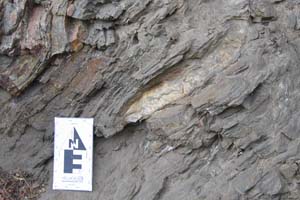
Our most recently funded project takes advantage of a rare opportunity in the Himalaya: a chance to study putative klippen of the South Tibetan fault system within the Lower Himalayan foothill ranges of Bhutan. Most exposures of the South Tibetan fault system occur at high elevations, near the crest of the Himalaya and along the southern edge of the Tibetan Plateau. Detailed studies of those structures show that most have experienced long and kinematically complex deformational histories beginning at least as far back as 23-20Ma. Late-stage deformation has largely obscured the early structural history of most range-crest exposures of the South Tibetan fault system, but a series of klippen in the foothills of Bhutan appear to preserve pristine segments of the system that have not experience late-stage slip. Frances Cooper will lead our efforts will leverage these unique exposures to better understand the early history of the South Tibetan fault system.
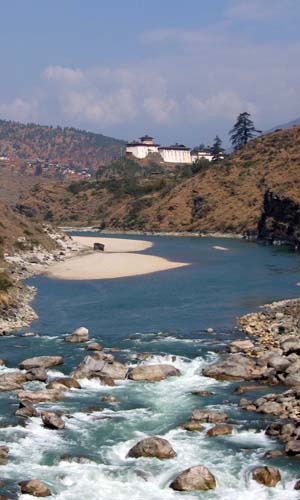
The topographic profile of western Bhutan is significantly different from that of other sectors of the Himalaya in a way that implies a distinctive tectonic evolution. The most strikingly distinctive feature of western Bhutan is an extensive low-relief "bench" at ~3000 m that interrupts the otherwise steep southern flank of the Himalayan ranges. Preliminary geomorphic analyses have led some researchers to suggest that this surface is a perched paleo-erosion surface that has been uplifted to its present position from a lower elevation. The postulated cause for the implicit accelerated erosion is a Late Cenozoic (post-Middle Miocene) change in deformation rate or kinematics or a change in climate. East of the Kuru Chu, a major north-south river that bisects Bhutan into western and eastern parts, the paleo-erosion surface is either missing or too poorly defined to be obvious from the analysis of remote sensing data.
PhD candidate Byron Adams is leading our work on the age, origin, and tectonic significance of the physiographic bench of western Bhutan. Building on research already begun at the University of Texas – El Paso by former PhD student Jose Hurtado and his former MS student Tobgay Tobgay, we are employing morphometric analysis of bedrock streams to define domains of differential rock uplift and we are constructing detailed structural maps of the boundaries between domains in order to understand better the deformation that accommodates differential uplift. A special focus of this work will be the abrupt eastern termination of the paleo-erosion surface, which may be a major, as-yet unmapped, fault. We are working to constrain the age of the paleo-erosion surface, date the structures that may bound it, and determine when the accelerated erosion that resulted in the current topography of western Bhutan by combining 40Ar/39Ar and (U-Th)/He geochronology. Collectively, these data will be interpreted in the context of the regional Late Cenozoic tectonic setting – especially the Early Pliocene (?) development of the nearby Shillong Plateau to the south, which blocks eastern Bhutan from the full impact of summer monsoon storms sweeping northward from the Bay of Bengal.
Constraining the Age of India-Asia Collision Through Detrital Mineral Thermochronology of the Indus Group, NW Indian Himalaya
Continental sediments of the Indus Group of northwest India unconformably overlie the tectonic collage produced by India-Asia collision and thus provide a critical constraint on the age of the collisional event. Although deposition of the Indus molasse is widely regarded as having begun in Lutetian-Ypresian time, this perspective is not explicitly supported by paleontological or geochronological data. Other than the fact that most of the molasse must be younger than Ypresian nummulitic limestones, age-diagnostic fossils or volcanic horizons have not been identified throughout most of the section, and the stratigraphic position of the only well-documented fossil assemblage from the Indus Group (Upper Oligocene ostracods) is debatable. there are no firm
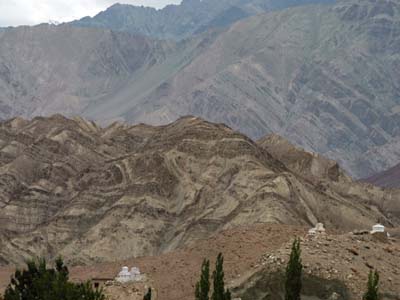
PhD candidate Alka Tripathy is using detrital mineral thermochronology to greatly improve our understanding of the age range, depositional history, and thermal evolution of this important sedimentary succession. Her principal tools are laser fusion 40Ar/39Ar biotite thermochronology and both laser heating and laser ablation (U-Th)/He zircon thermochronology. The first method capitalizes on the wide distribution of biotite in Indus Group sandstones and on the fact that post-depositional metamorphism of the sequence was at a low enough temperature to eliminate the possibility of thermal resetting of the 40Ar/39Ar biotite chronometer. Thus, the youngest detrital biotites in each sample provide an upper boundary of the sample's depositional age. The (U-Th)/He zircon chronometer, on the other hand, has a closure temperature range low enough that it should have been reset by post-depositional metamorphism in the highest-grade portions of the Indus Group sequence. The zircon ages from these parts of the sequence will provide a lower boundary on depositional ages of all parts of the sequence, since the entire depositional basin experienced epizonal-anchizonal metamorphism at that time. In addition to these important brackets on the age of sedimentation, the results of this study also will provide better insights into the provenance of Indus Group sediments, the likely developmental age of the modern Indus River drainage system, and the age of regionally important deformation that accompanied epizonal-anchizonal metamorphism.
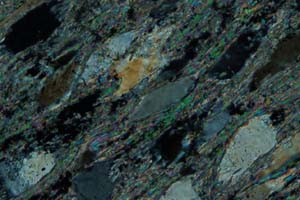
Development of the Eastern Himalayan Fold and Thrust Belt, Bhutan
In collaboration with Professor Nadine McQuarrie of Princeton University, postdoctoral researcher Frances Cooper will be using the 40Ar/39Ar laser microprobe to date polyphase deformational fabrics related to shortening in the Lesser Himalaya of Bhutan. Integration of this work with structural mapping and metamorphic petrology done by Nadine and her students should reveal how deformation was partitioned through time and space in this part of the Himalayan-Tibetan orogenic system.
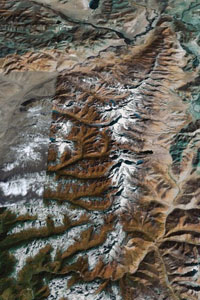
Extensional Fault Systems of the Ama Drime Range, southern Tibet
Much of the recent literature on the Himalayan-Tibetan orogenic system has focused on the role of monsoon climate in its development. In one controversial hypothesis, aggressive monsoon precipitation currently attracts the southward flow of a channel of middle crust from beneath the southern Tibetan Plateau to the Himalayan orogenic front. Fortunately, this hypothesis makes a number of predictions that are readily testable. One of these predictions is that a recently active detachment occurs along the southern edge of the Tibetan Plateau at the approximate position of the Miocene South Tibetan fault (STF) system. A study of this kind conducted several years ago in the Annapurna and Dhaulagiri ranges of Nepal yielded evidence supporting the existence of such a structure but exposures of critical contacts were poor – all were just south of the plateau margin and thus in an area of heavy vegetation – and both the reliability and the broader implications of the results of that project have been questioned.
PhD candidate Jeni McDermott is addressing this issue in another area that has far better exposure: the Ama Drime Range of southern Tibet (N27˚54’-28˚30’; E87˚20’-87˚45’). Geologic mapping and (U-Th)/He thermochronology thus far suggest at least three generations of extensional structures in and around the range. At least two of these are related to Early Miocene and Late Miocene slip on the STF system, both older than Quaternary, N-striking normal faults that bound the range. A discontinuity in the pattern of cooling ages at the physiographic transition marking the southern plateau margin may indicate active STF faulting. Exploring this possibility further, Jeni is evaluating the case for Quaternary channel extrusion with the intention of either falsifying the hypothesis or establishing the structural and geomorphic consequences of deformation related to the upper bounding structure of the extruding channel. Regardless of the outcome, the data obtained will provide new insights regarding the development of transverse metamorphic culminations in collisional settings.
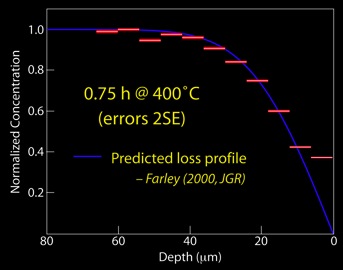
Helium Diffusion and Alpha Ejection
The ArF excimer laser microprobe is an excellent tool for high-precision profiling of 4He diffusion and alpha-ejection gradients in minerals. In vacuo diffusion experiments on Durango fluorapatite by research scientist Matthijs van Soest, postdoctoral researcher Brian Monteleone, and former PhD student Jeremy Boyce have yielded profiles consistent with bulk diffusion coefficients obtained independently for that material. Natural alpha ejection profiles, measured orthogonal to crystal faces in Durango fluorapatite, indicate alpha stopping distances in that material that are somewhat shorter than theory predicts, suggesting the need for further empirical studies using laser ablation (or other) techniques.
Laser Microprobe (U-Th)/He Thermochronology
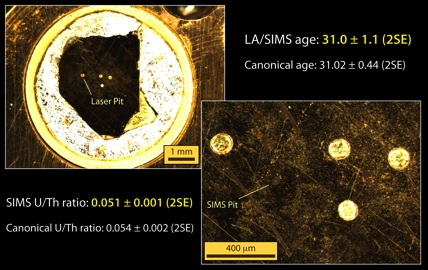
Research scientist Matthijs van Soest, postdoctoral researcher Brian Monteleone, and former PhD student Jeremy Boyce (now at UCLA) are leading efforts to develop microanalytical(U-Th)/He thermochronology. We extract radiogenic helium using an ArF excimer laser microprobe and we measure radioactive parent isotopes in situ using secondary ionization mass spectrometry (SIMS). The principal value of this technique is that it provides away to avoid the need for alpha ejection corrections, thus minimizing analytical uncertainties arising from such corrections. As a consequence, the technique permits us to date non-euhedral grains such as those commonly found in detrital samples. Thus far we have demonstrated success with the technique for monazite, apatite, and zircon.
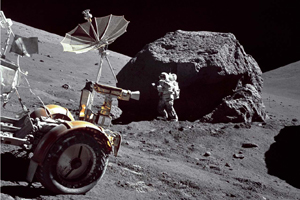
Lunar Field Geology
In anticipation of NASA's return to the Moon, Kip Hodges is exploring new, technology-enabled approaches to field geologic research on planets other than Earth. Colleagues Chris Assad (JPL), Win Burleson (ASU), and Dava Newman (MIT) are working with Kip to design and test protocols for scientific extra-vehicular activities by human-robotic exploration teams. Working with Apollo 17 astronaut/geologist Harrison Schmitt (right) and other members of the Field Exploration Analysis Team (FEAT) – such as Mark Helper (University of Texas) and Art Snoke (University of Wyoming) – Kip is helping NASA prepare a new generation of astronaut explorers.
Ultrahigh-Pressure Metamorphism in the Tso Morari dome, NW Indian Himalaya
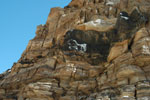
Coesite-bearing eclogites, indicative of metamorphism at pressures in excess of 22 kb, are found in two places in the Himalayan orogen: the upper Kaghan Valley of Pakistan and the Tso Morari dome of northwest India. These eclogitic terrains are thought to provide evidence for continental subduction of the northern margin of India beneath Eurasia during the early stages of Himalayan orogenesis. Following on the work of former MS student Ryan Clark, postdoctoral researcher Brian Monteleone has been studying the Tso Morari examples in an effort to better understand the processes of continental subduction and the exhumation of subducted continental fragments.
The Tso Morari dome is a metamorphic core complex, structurally analogous to metamorphic core complexes found in the western North American Cordillera. Its core, consisting of eclogite-facies gneisses and schists rocks that host the coesite-bearing mafic eclogites, is surrounded by metasedimentary and metaigneous units
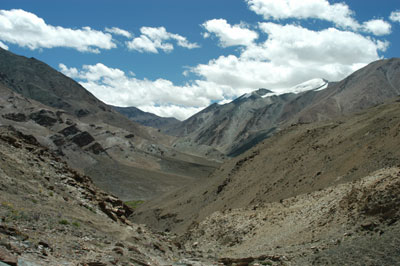
Our work focuses on the movement history of such structures, as well as their role in the exhumation of the ultrahigh-pressure rocks of the core. To compliment our detailed structural research, we are integrating the techniques of metamorphic petrology and 40Ar/39Ar and (U-Th)/He thermochronology in an attempt to develop a high-resolution record of the pressure-temperature evolution of distinctive rock packages bound by these structures. Ultimately, we hope to use the resulting data to evaluate alternative thermomechanical models for the early stages of Himalayan orogenesis.